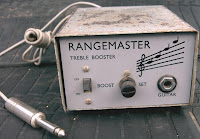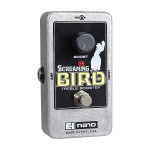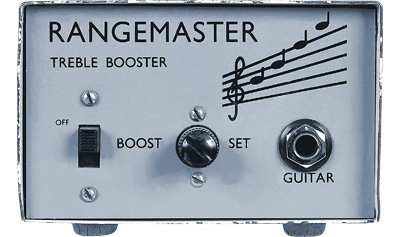The Dallas Rangemaster Guitar Treble Booster!
This small grayish gear box pretty much defined British Rock and Roll of that era and was used by Eric Clapton during his stint with the Bluesbreakers. Later devotees of the Rangemaster included Rory Gallagagher, Toni Iommi, and most notably, Brian May of Queen. The Rangemaster wasn’t actually a stomp box at all, but was originally intended to sit on top of an amp and act as the amps front end. One knob handles loudness while a slide switch bypasses or engages the effect. What the Rangemaster does is add a bit of high-end punch and presence to your sound. With a healthy 10db of boost, this device has no problem pushing the front end of your amp with a sweet crunchy overdrive.

Treble Boosters Create the Guitar “Sweet” Spot
Treble boosters in general, create the “sweet” in guitar tones, although with many units I have found the need to turn the treble down on the amp. The vintage Dallas is hard to come by (though a few guitar geeks out there are building similar models these day). Less compressed than a distortion or overdrive pedal, it allows you to play balls-to-the-wall without sacrificing nuance.

Electro Harmonics also makes an inexpensive model that I’ve heard excellent things about, and at around $40, it seems like a great investment for killer tone.
History of the Treble Booster
Interestingly, the treble booster really was designed to do what its name purports– to boost the treble in your signal. Some music historians believe that amps from the 50s and 60s tended to deliver a darker tone, hence the need for the effect.
What I mean by “nuance” when talking about treble boosters for guitar players
The Bottom Line for the best overdrive
Treble booster are still the ultimate way to get a killer overdriven tone without sacrificing the expressiveness inherent to the instrument.
To be honest, I think some of the art of guitar playing has been lost with the advent and adoption of overdrive and distortion pedals. No doubt, they are wonderful effects that open the doors of creativity and have defined musical styles over the last thirty years or more. But like all things in life, gains are often made by sacrifice.
And what I mean is that too many guitar players today, have either forgotten or have never known that their instrument can be just as expressive as an orchestral string instrument or a piano. And in some ways, even more so than an acoustic; an electric guitar can provide as much sustain as a bowed instrument (with feedback, even more).
So treble boosters, especially the Dallas Rangemaster (the one by which all other treble boosters are judged) have become sort of like the Archimedes Codex. Something lost to time. Very few guitar players even know about them. I have had conversations with some incredible players who grew up on guys like Brian May, Black Sabbath and Led Zeppelin (I’ve heard Jimmy page used a Rangemaster on the first Led Zeppelin album), and had no idea these things existed.
So my advice to all guitarists out there, is to get hold of a treble booster and mess around with it for awhile. Not saying you should retire your Tube Screamer or MXR Distortion, but definitely check one out and see what happens. It may even take a little tweaking to get it to really sing.
And like I said earlier, there are so many makers, so it needn’t cost you $300 or more to get a repro of a Rangemaster (although they are totally figgin’ cool!) to plunk down on top of your amp. In fact, for less money, there are many guys that took the same Rangemaster circuitry and stuck it in a stomp Box!
You may well find that it’s totally worth it to try a treble booster if you’ve been looking to capture the sound of your favorite 70s Guitar Rocker and haven’t had any success.
by Jonathan Schlackman




 Email
Email Twitter
Twitter GooglePlus
GooglePlus